Art galleries opening all over the city with art as international as innovative. Given London, more than 1.500 galleries, its current art scene is one of the world’s biggest market; a strong rival to Paris, Los Angeles, New York or Shanghai.
NOT EVERYONE WILL BE TAKEN INTO THE FUTURE
Now, that Soho is no longer the shabby but lively area it once was and has largely lost its reputation as a bohemian enclave, in retrospect, from the mid-1930s through to the mid-1980s numerous artists, writers, and others congregated in Fitzrovia and Soho, today artists and the contemporary art scene moved to the East End with the exception of Mayfair alone. The art scene wasn’t the same until the late 80s, when a bunch of kids out of Goldsmiths, the Young British Artists, changed all that.
Our review, however, is not about them; it is a story about three remarkable places and people in London who share nothing in common, but they are unique and revolutionary in their own way. A gallery in Mayfair run by two French entrepreneurs, a well-established South East gallery currently showing a Russian couple from the ex-Soviet era and a Haggerston based foundation established by a genius, Brit, iconic designer.
There is no more sacred, than a story and not everyone will be taken into the future. True or “fictionary”.
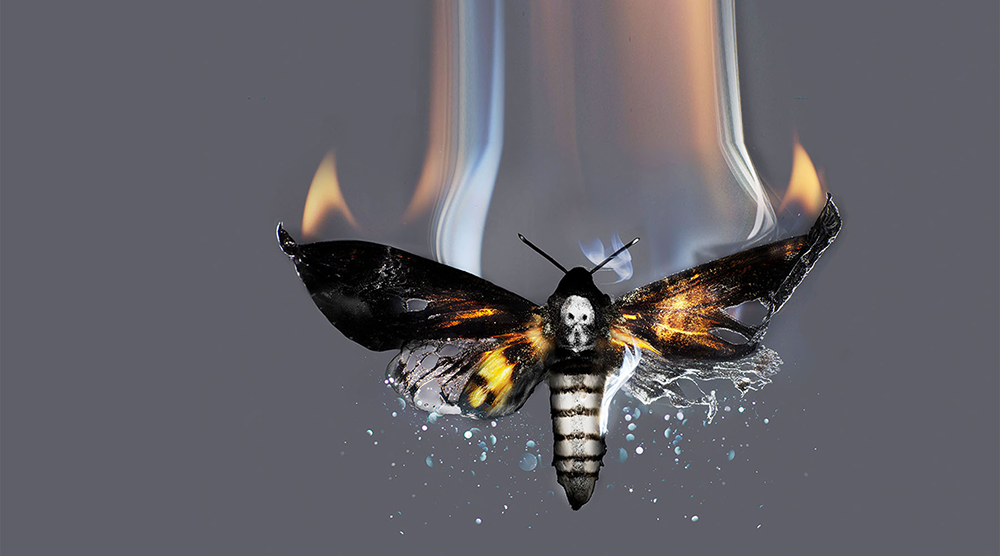
SARABANDE FOUNDATION / LEE ALEXANDER MCQUEEN
Lee is definitely in the future. But who is really Lee Alexander McQueen? (put deliberately in present tense). He is undoubtedly one of the most genius designers of our time and his name is not just graved into the fashion industry but also strongly identified with his multidisciplinary foundation.
PORTRAIT in 30’
Lee was born in London in turbulent 1969. At the age of 16 he begins an apprenticeship on Savile Row, then subsequently moves to the land of theatrical costumiers and masters the methods of pattern cutting from melodramatic to razor-sharp tailoring. After having graduated from St Martin’s in 1992, he establishes his own label, and in 1996 is appointed at Givenchy until 2001
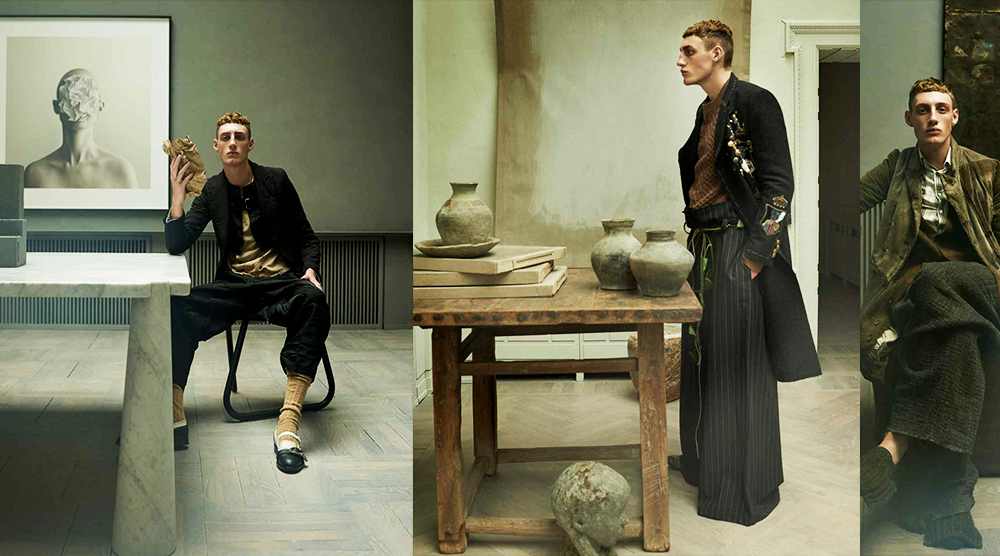
A SPACE OF INSPIRATION
Established after Lee’s death in 2010, the Sarabande Foundation, once functioning stables with horses, provides a space for designers to experiment with diverse art forms, collaborate with patrons and run fundraising activities.
Named after McQueen’s collection, the Sarabande Foundation is run by the close friend and business partner of McQueen, the passionate Founding Trustee, Trino Verkade, houses a group of designers, a good blend of creatives. Scholars are offered a scholarship at the graduate and postgraduate level and a workspace after their graduation from 12 months to two years. The trustees, on the other hand, did not just want to give out scholarships, they wanted to find a more collaborative way to keep Lee’s legacy. After having found a building near the canal in Haggerston that felt right to house designers and the studios, the Foundation opened in 2015. The inhabitants did not just receive financial support; but also a moral support, and a lot of support that the designers in the studios gave to each other.
The Foundation support system allows them to be fearless and spend time on their experimentations in a practically stress-free environment. The only requirement is to be passionate and inspirational. The Foundation also pays a great attention to their developing relationships with industry professionals.
Lee passionately believed that creative minds should push their boundaries; they should be given great opportunities he had enjoyed for a long time, and their work should not be held back by any financial constraints. He had a deep appreciation for creativity and loved to collaborate. It is that openness and bravery that the Sarabande Foundation seeks to inspire the future generation of designers.
The patrons are Nick Knight OBE, Andrew Bolton, Shaun Leane, Naomi Campbell, Sam Taylor-Johnson and Tim Blank. Others, including Jake Chapman, Matthew Slotover, Katy England and Sarah Burton OBE worked with the Foundation to select scholarships.
The designers, some are still inhabitants, are John Alexander Skelton, Katie Roberts Wood, Molly Goddard, Erik Litzen, Sinead Dolores Cloonan and Craig Green who recently left the Foundation to open his own workspace.

EVENTS & TALKS
The Sarabande Foundation is well known for their talks and discussion panels held on the first floor. In 2017, actor Eddie Redmayne had an intimate discussion with multi-Academy Award-winning costume designer Colleen Atwood, Jonathan Wingfield with editor Tim Blanks of Business of Fashion, Harriet Quick with Andrew Bolton and writer Mimma Viglezio with iconic fashion photographer Nick Knight of SHOWstudio. For 2018, Thom Browne, Mat Collishaw and Kickstarter are confirmed so far.
The Foundation also holds art exhibitions for artists-in-residence, including Donal Sturt, Saelia Aparicio Torinos, Jocelyn McGregor and as part of the Fashion Revolution programme, curator Tamsin Blanchard revisited the art studios and designer-in-residence, John Alexander Skelton at the Foundation. For 2018, a series of live drawing sessions are planned following by art installations with Mircea Teleaga’s paintings in April and Rosa Uddoh for Craft Week in May.
The direction of Trino Verkade stays firm in programming, focusing on passion, dedication and practicality that make the Foundation today relevant and revolutionary.
Sarabande, Lee Alexander McQueen Foundation, 22 Hertford Road, London N1 5SH / 1 & 8 February 2018 Life Drawing Events
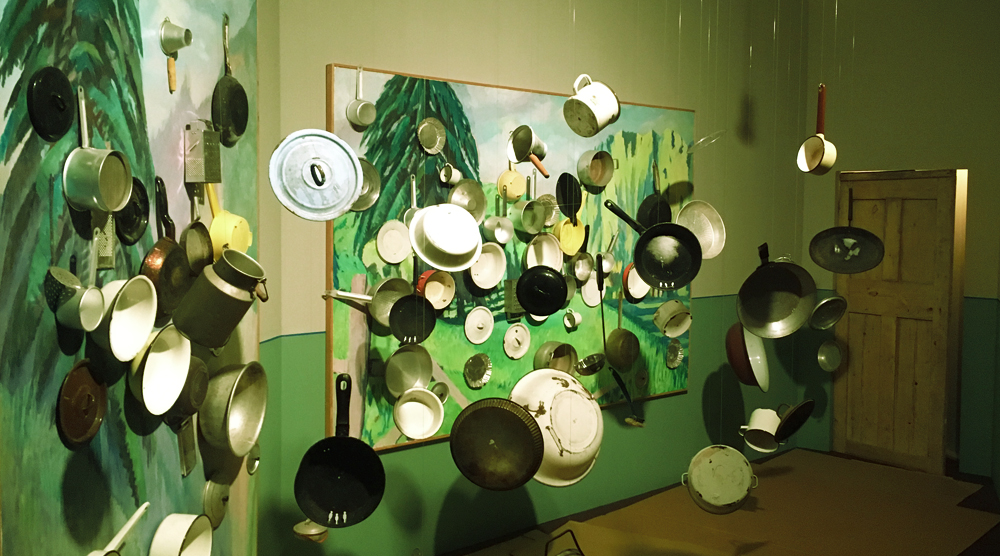
TATE MODERN / ILYA & EMILIA KABAKOV
On the planet Kabakov, a terrifying journey to the dark side of the former Soviet Union. The first major UK exhibition dedicated to Ilya and Emilia Kabakov, the true pioneers of large-scale installations and the use of fictional characters from propaganda art invented in their Moscow studio, and its highly optimistic depictions of Soviet life.
PORTRAIT in 30’
Ilya and Emilia Kabakov were born in Dnepropetrovsk, in what was then the Ukraine of the Soviet Union. He begins his career in Moscow as an illustrator during the 1950s; she attends a music school and studies literature. He is part of a group of conceptual artists who work outside the official Soviet art system and in 1985, he receives his first solo exhibition in Paris. Two years later he moves to the West; she emigrates to Israel, then to New York. In 1988, they begin to work together and Emilia becomes his future wife. Today Ilya & Emilia Kabakov are the most recognized Russian artists to have emerged in the late 20th Century.
HOPE & FEAR
The exhibition is broken into rooms of installations, each providing a unique experience and exploring the visual culture of the former USSR. Hope and fear. How could it be more relevant than today? Kabakov’s work addresses universal ideas of utopia and imagination. The exhibition takes the visitor through an incredible journey, from the early paintings and sculptural works made from the 60s up until the late 80s when he moved to New York. A turning point which marked his collaboration with Emilia on large-scale installations and architectural models of utopian projects to attack the USSR’s state domination over the individual mind.
Throughout the exhibition three major and rarely exhibited installations are presented for the first time: “The Man Who Flew into Space from His Apartment”, “Labyrinth (My Mother’s Album)” and “Not Everyone Will Be Taken Into the Future”. These uncanny environments draw the spectator into absurd and moving stories of fictional characters playing with the notion of personal identity. Kabakov’s work is influenced not only by visual art but by literature, particularly the Russian narrative tradition of Chekhov and Dostoevsky.
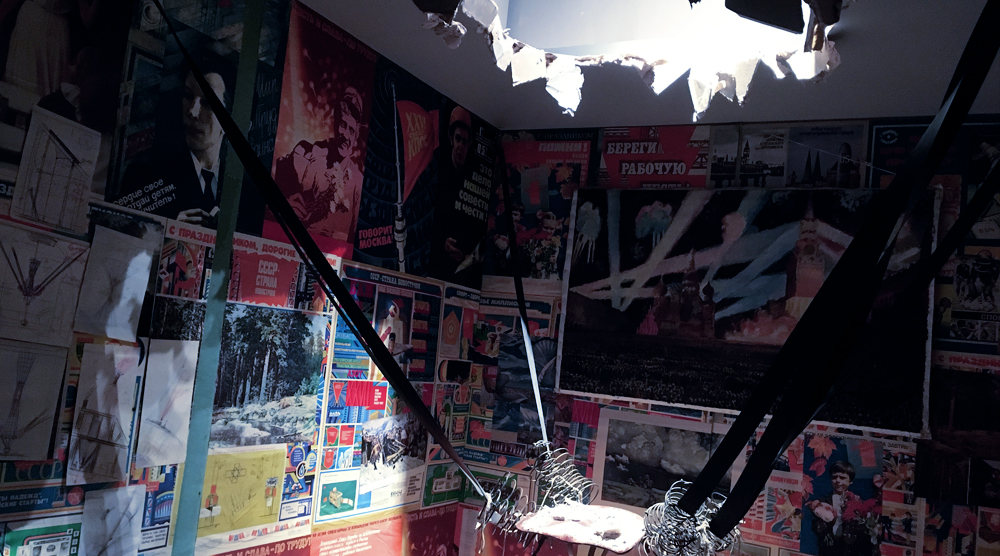
SPACE RACE
Kabakov grew up in a climate where only officially approved art was endorsed. As a visual reflection to the Cold War during the “space-race” between the US and the USSR, “The Man Who Flew into Space from His Apartment” blows off the constraints of socialist realism. It is a series of rooms of a communal apartment, in which generations of a family crammed into a single room and shared all the facilities. The pots from the communal kitchen hang suspended in mid-air; objects nicked from neighbours are piled on a table.
The installation is a metaphor of Soviet life. This complex work ridicules Soviet technological ambition and holds a mirror reflecting the reality of everyday life in Russia. At the core of the installation a smashed wooden door leads into another room, the tiny space is entirely wallpapered with communist propaganda posters with an obscure, slingshot-like catapult built in the middle, and a hole blasted in the ceiling, where our fictional man finally managed to burst away from the tyranny of his life for a space mission. Escape and Freedom.
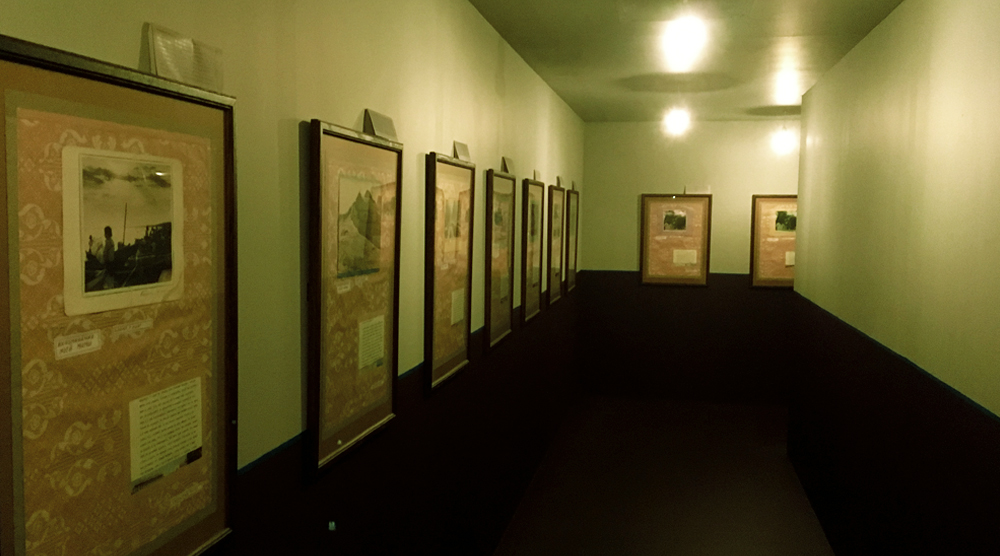
IN MY MOTHER’S LABYRINTH
Kabakov, a few years before her mother died persuaded her to start her memoir. “Labyrinth” is a seemingly endless, harrowing installation with a set of dreary, under-lit corridors turning one corner to another, only to find yet another claustrophobic corridor filled with typewritten excerpts from her autobiography, juxtaposition with photographs of a Russian coastal city and hang on one side of the walls. The corridors lead to the end of the maze filled with rubbles and an echoing, melancholic sound of singing old Russian songs from Kabakov’s childhood. The installation gives the viewer a similar experience of being trapped in time waiting for something that will never arrive.
“Numerous corridors have persecuted me all my life – straight ones, long ones, narrow ones, but in my imagination, they are all poorly lit and always without windows, with closed doors along both sides. All the corridors of my life, from earliest childhood on, have been connected with torture of endless anticipation.”
NOT FOR EVERYONE
Coinciding with the centenary of the 1917 Russian Revolution “Not Everyone Will Be Taken Into the Future” explores the role of an artist in society in uncertain times. It is a sinister underground station where a train is about to crush paintings and history will cruelly overtake art. The Soviet Union is gone but millions lived and died through its cruel, devastating regime, millions more were left imprisoned because they spoke out against their government. Now it is time for their monument.
ANGEL IN THE SKY
“How to Meet An Angel” is a truly beautiful, full-size installation in the final room. A landscape with a river, fields and forest, with an intricately constructed ladder arising upward towards the sky, in the middle of nowhere. There is a figure at the end of this ladder reaching out for an angel …
“An encounter with your angel in real life appears to be virtually impossible. But that is far from the truth. All that is necessary is to recall that this encounter can take place in extreme circumstances, and especially at critical moments in a person’s life”.
That is where hope comes in and takes the fear away …
Tate Modern, Bankside, London SE1 9TG / “Not Everyone Will Be Taken Into The Future” Ilya & Emilia Kobakov – until 28 January 2018
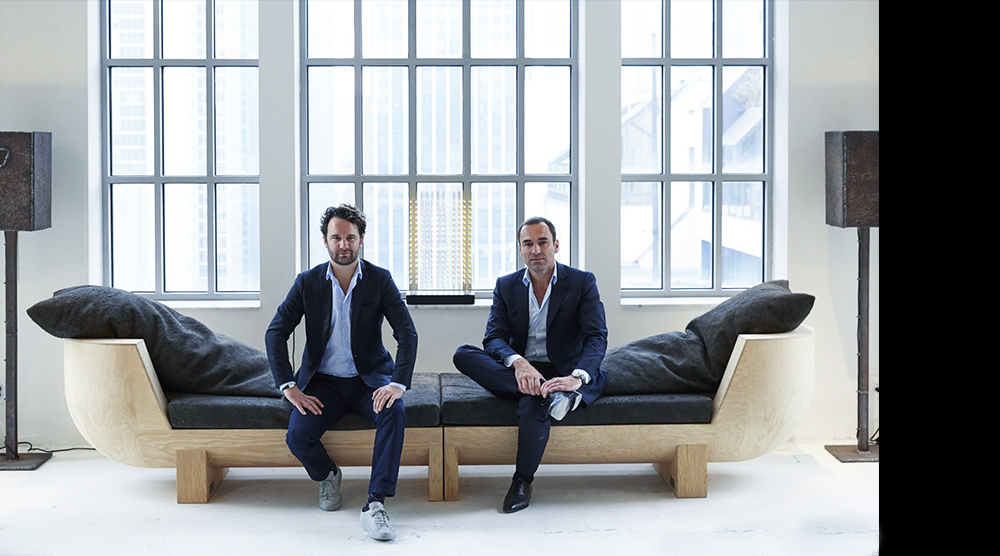
CARPENTERS WORKSHOP / LOÏC LE GAILLARD AND JULIEN LOMBRAIL
The two French entrepreneurs, Loïc Le Gaillard and Julien Lombrail of Carpenters Workshop Gallery have a significant role in future design. They have both sharp eyes to find designers who no longer do industrial design but creating a new kind of discipline that is art. Their galleries in Mayfair, Le Marais, Fifth Avenue and on Montgomery are multidisciplinary places, cultural bridges, transcending classical borders in terms of contemporary art and design.
Carpenters Workshop produces and exhibits functional sculptures by internationally emerging and established artists, designers, going outside their traditional territories of visual and emotional expressions. The gallery is also actively involved in the research and production of the limited edition, exhibited pieces.
Carpenters Workshop in London is currently showing bronze work by Vincent Dubourg, Andrea Branzi, a pop-up installation in San Francisco collaboration with the gallery 836M and Maarten Baas new exhibition in Paris is replacing “The graduate(s)” European Design Talent selected by Lidewij Edelkoort.
PORTRAIT in 30’
Carpenters Workshop, branches in London, Paris, New York and a pop-up space in San Francisco, opens in 2006, in Soho and later in 2008, in Mayfair. Their first exhibition shows paintings from Chinese artist Zhang Huan, followed by a collaboration with Sotheby’s in 2010, for a design exhibition with upcoming and established designers including Pablo Reinoso. In 2011, a 600sq meter space opens up in Paris.
In 2012, the gallery dedicates an exhibition to the British Collective Random International “Before the Rain” in their Parisian space, in 2013 exhibits in London a selection of furniture created by Rick Owens and in 2014, at the Biennale des Antiquaires they are the only contemporary design gallery to be given a space.
New York is the latest of the Carpenters Workshop galleries. The new space confirms the leadership and dominant position in art and design internationally.
In 2015, in addition, the gallery opens an 8,000m2 workshop in Roissy, for their artists to combine their research with production.
Carpenters Workshop is present at around 15 international Art & Design fairs a year, including PAD London, PAD Paris, Design Miami, Design Miami/Basel, TEFAF and the Armory show in New York.
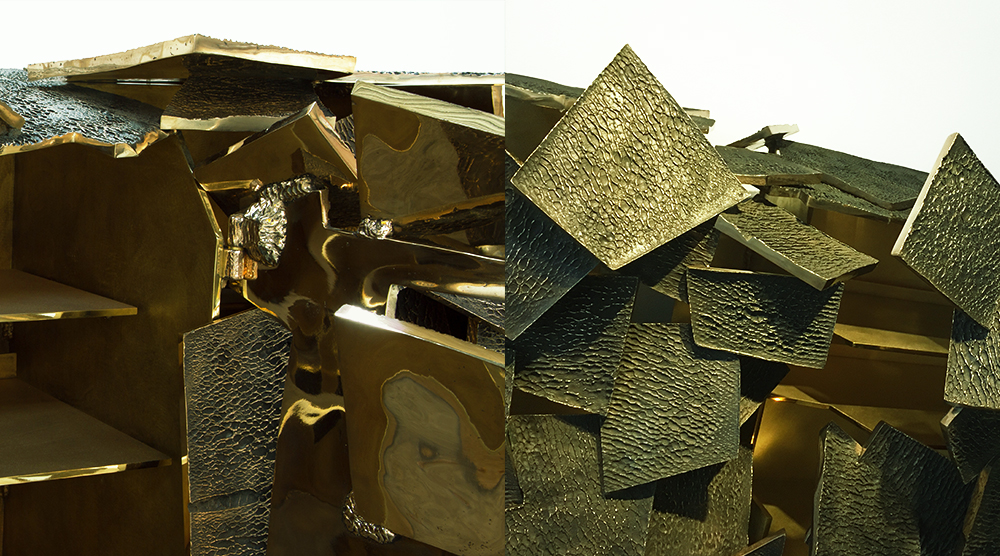
A POET IN BRONZE
Vincent Dubourg is a poet. His sculptural furniture makes contemporary allusions to traditional methods of cabinetmaking. This evokes a nostalgic sense of the familiar, which he simultaneously distorts with his fresh approach to materials and techniques. Dubourg fuses the crafts of glassblowing, wood-bending, and metal-casting to bring simple forms to life. His designs combine motion with stationary furniture His series “Bhanga Bronze” and also “Vent Sur La Table” whirls bronze and branches upwards as though freed from the constraints of gravity. Flipped bars, flying shelves, rows of upside-down glasses and bottles give a new perspective to furniture design.
Dubourg’s conceptual twists add a surreal element to traditional craftsmanship, though he never relinquishes his devotion to the search of perfection.

SASSI E LEGNI
“Sassi e Legni” is an exclusive solo show by the renowned Italian designer Andrea Branzi. A graduate of the Faculty of Architecture in Florence, pioneer of architecture and radical design, Branzi is known for his intellectual approach to design. His work questions the presence of man in our environment, space, and objects while proposing a democratic and fluid perspective. His numerous projects analyze the relationship between the natural environment and the built environment.
His latest work “Sassi e legni’” began the production of a domestic micro-architecture, combining nature and artistic creation with a pictorial gesture. A synthesis, a thought, a masterpiece. Bringing industry and nature together. His artistic approach connects the industrial world to the poetry of nature. In his piece “Tree”, combining two opposing worlds, he notes: “Trees, trunks and branches are part of an ancient culture but also of actual culture. The work consists to place simple everyday objects, books and images next to the strange presence of branches and trunks, like in the reality of the world.”
THE GRADUATES
A new generation of designers responding to our chaotic age, investigating their identity and roots, often going back to the beginning of time to uncover authenticity and primal instincts.
The brut expressions that result from this movement dominate the exhibition.
“The graduate(s)” European Design Talent show is selected by Lidewij Edelkoort including Martin Laforet, Thomas Ballouhey, Priyanka Sharma, Carlo Lorenzetti, Anton Hendrik Denys.
The graduates catalogue their experiences by imagining unknown artefacts; remnants of a distant past rendered in raw materials such as sand, stone, clay and concrete, warmed up by natural woven and wild fibres. These young artists create hybrids between the industrial process and the handcrafted, reincarnating found fragments and composing collages; thus proposing rituals for a more humble and sustainable lifestyle, and envisioning a form of contemporary archaeology.
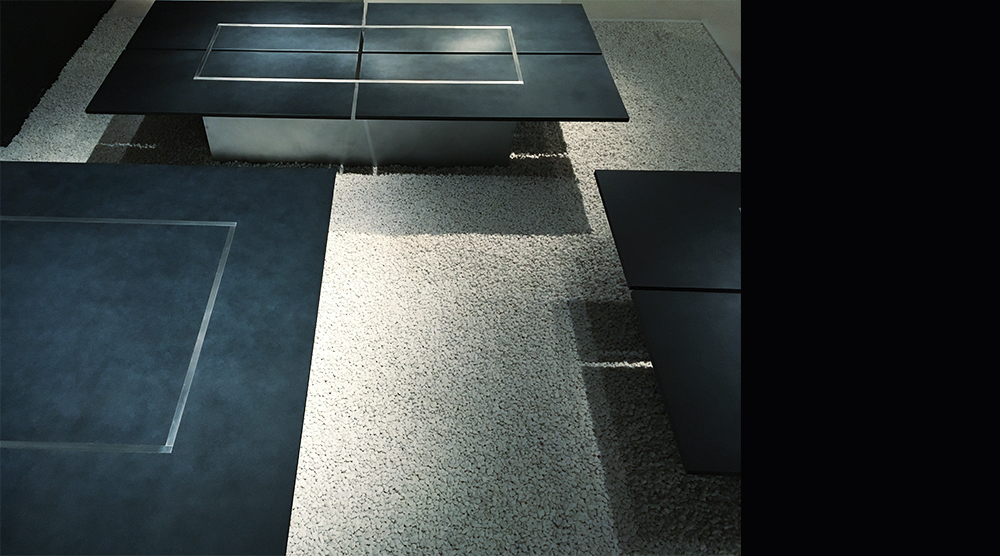
LUST FOR LIFE
2017 was another successful year for Carpenters Workshop Galleries, highlighting Vincent Dubourg “Vortex”, first shown in New York then London, Mathieu Lehanneur “Ocean Memories” and Robert Stadler “Solid Doubts” in New York, Charles Trevelyan “Aspects” and Maarten Baas “Run & Hide in London, Wonmin Park “Plain Cuts“, Wendell Castle “Planting Seeds” and Nacho Carbonell “Forest” in Paris including the installation of Atelier van Lieshout “Domestikator” on the piazza of Centre Pompidou, creating a scandal during the week of the FIAC.
The upcoming exhibitions in 2018 list Atelier van Lieshout “Lust for Life Lamps” in London, Wonmin Park “Plain Cuts” in New York and Maarten Baas “Close Parity” in Paris.
Carpenters Workshop Gallery, 4 Albemarle Street, London W1S 4GA / “Lust for Life Lamps” Atelier van Lieshout – 1 February – 11 May 2018
Paris 54 rue de la Verrerie, 75004 / “Close Parity” Marteen Baas – 18 January – 23 March 2018
New York 693 Fifth Avenue, 10022 / “Plain Cuts” Womin Park – 24 January – 14 April 2018
San Francisco at 836M Gallery, 836 Montgomery, 94133 / pop-up for Carpenters Workshop Gallery throughout January 2018
COVER PHOTO: “The Man Who Flew Into Space From His Apartment” by Ilya Kabakov, “Wilf” by Sarah Stedeford and “Aubrey O’Mahony” by Damian Foxe in John Alexander Skelton’s collection at Sarabande Foundation / Photo-montage © Courtesy of ZOLTAN+
Text and photos by the courtesy of Zoltan Alexander © ZOLTAN+ London

